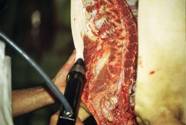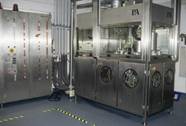On-line sorting
Several investigations of rapid technologies with a potential for boar taint detection have been conducted based on various measurement principles (Lundström et al., 2009):
- Chemical sensor arrays ("electronic noses" for volatile compounds)
- Mass-spectrometry fingerprinting (sampling of vapour into the ion-source followed by mass fragmentation)
- Ultra-fast gas chromatography (based on androstenone, skatole and indole but sampling needs to be further developed)
- Gas-phase spectrometry (needs to be adapted to on-line use)
- Biosensors (use of insects seems promising).
The only analytical method, that has been put into practice on an industrial scale for the purpose of sorting boar tainted carcasses is the skatole method installed at Danish slaughterhouses in 1991 - 1993. It is a colorimetric method measuring skatole. It is a fully automated analysis robot with a capacity of 200 samples an hour. Skatole content is determined in every male pig. The time for each individual analysis is 20 minutes, which means that the result is available when the carcass comes out of the chilling tunnel. About 4-5 % of carcasses are rejected based on a threshold of 0.25 ppm skatole.



Spectrophometric method used in Danish slaughter plants (sampling of back-fat, sampling station and automatic analysis). Source: Danish Meat Research Institute.
From an analytical and technical point of view this method is not up to date. Furthermore, the capacity is limited and androstenone is not analysed. Therefore, there is a growing demand in the meat industry for objective automated non-destructive techniques to characterize the flavour of pork.
There are no harmonized and consistent on-line methods of identifying carcasses with boar taint in commercial slaughterhouses. The methodologies developed so far are still too costly, and too slow, and require highly qualified staff (Lundström et al., 2009); furthermore they need to have a performance rate of 100 % correct classification of both acceptable and non-acceptable samples with regard to boar taint.
Investigations of meat processing techniques to reduce the offensive properties of boar taint are hampered by the lack of methods of assessing levels of the compounds contributing to the phenomenon (EFSA, 2004).
A risk-based testing system has been discussed. The risk analysis could be based on age, weight, genetics, feeding and management and lead to on-line testing of high-risk animals. A risk-based system needs to be analysed further.